All
An Epic Start
by Samuel Diamond

The 2017-2018 heating season might have started slowly, but it quickly crescendoed to a boom … or rather, a bomb.
A storm can be considered a “bomb cyclone” if its pressure falls 24 millibars in 24 hours. The winter storm that blasted practically the entire East Coast during the first week of January featured an astonishing pressure drop of 59 millibars in 24 hours, making it one of the most explosive storms on record.
“The rapidly dropping atmospheric pressure in the center of the bomb cyclone was opposed by the much higher pressure of the Arctic air covering New England,” explains Fax-Alert Weather Service Meteorologist John Bagioni, “and the result was powerful winds developing around the storm.”
Powerful indeed! Gusts clocked in at 75 mph along coastal Massachusetts, where snowfall totals topped 13 inches. But that wasn’t the worst of it. Bangor, Maine received 18.3 inches on January 4, breaking the city’s previous snowfall record for that date. Daily records for January 4 were also eclipsed in Bridgeport, CT (8”); Hartford, CT (10.2”); Boston (13.4”); Worcester, MA (16.8”); Concord, NH (13”); and Providence, RI (14.1”).
Another area of concern: “The coastal flooding, from Boston Harbor southward, was unlike anything we’d seen since the Great Blizzard of 1978,” Bagioni recalls.
And then there was the cold.
One widely circulated story told of a New Hampshire mountaintop where the wind chill forecast called for an unearthly 100 degrees below zero. While a -36ºF reading atop Mount Washington made for interesting headlines, conditions on the ground weren’t much prettier, as temperatures dropped to the single digits and lower across much of the Northeast U.S.
Icebreakers encountered glacial sheets greater than six inches thick at the Delaware River, Hudson River, Boston Harbor and other seaports. In Portland, ME, the daily low temperature dipped into the negatives on December 28 and stayed there through January 2 — six consecutive nights at subzero. 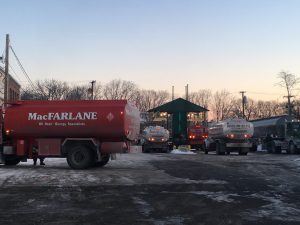 “The intrusion of cold air was truly something to behold,” Bagioni remarks.
“The intrusion of cold air was truly something to behold,” Bagioni remarks.
By any measure, it was a storm to remember.
Facing easily the harshest winter conditions since the Polar Vortex of 2014 — and by some accounts, the worst in a generation — the Northeast’s deliverable fuels industry rose to the challenge, just as it has so many times in the past.
“All Hands on Deck”
When the cold got worse, full-service fuel dealers dug in deeper.
“It was all hands on deck,” says Scott E. MacFarlane, vice president of MacFarlane Energy, of Dedham, Massachusetts. “The service teams were helping out on the oil side, my dad was out on the oil truck, I was out on the truck, and when the snow hit, we put helpers in all the trucks to expedite deliveries.”
Across the region, eight-to-10-hour office workdays stretched to 12- or even 16-hour marathon shifts. Dispatchers with CDLs jumped into cabs to relieve over-extended delivery drivers. Meanwhile, operational staff stepped in to help field incoming customer calls, with CSRs juggling multiple lines at once.
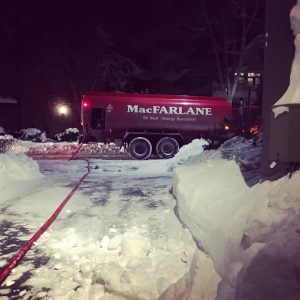 Though MacFarlane Energy had been ahead of schedule going into Christmas, delivery tickets piled up as locals carefully watched the 10-day forecasts. “Some customers start calling in a panic, some start cranking the heat, which throws their degree days off, and then the will-call requests start accumulating,” explains MacFarlane. The confluence of events made for a perfect storm.
Though MacFarlane Energy had been ahead of schedule going into Christmas, delivery tickets piled up as locals carefully watched the 10-day forecasts. “Some customers start calling in a panic, some start cranking the heat, which throws their degree days off, and then the will-call requests start accumulating,” explains MacFarlane. The confluence of events made for a perfect storm.
“From January 2-4, we saw a significant increase over our normal total gallons delivered, approximately double,” MacFarlane says. “We shoot to deliver 180 gallons on a regular 275-gallon tank, and most customers were taking 210-220, which is great for efficiency, but if you get a little higher than that you risk runouts.”
Even after the snowstorm ended, there were other obstacles to consider, MacFarlane says, like icy roads and driveways, as well as those snowbird customers who have flown south for winter, leaving their New England homes unoccupied. Still, MacFarlane Energy pulled together to keep as many of its neighbors warm as possible. “It can be stressful but that’s what we do.”
A Wake-Up for Will-Call?
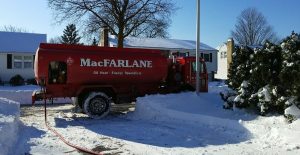
If January’s extreme cold snap brought out the best in New England’s full-service fuel dealers, at least some are hoping the extreme weather will also provide a kind of wake-up call for the industry as a whole.
“We figured out we still have winter,” jokes Mike Estes, president of Estes Oil & Propane in York, ME. Estes thinks that the harsh
conditions illuminated some major flaws in the on-demand, will-call delivery model. “Most of the full-service companies that have the majority of their customers on automatic delivery weathered the storm pretty well,” he says.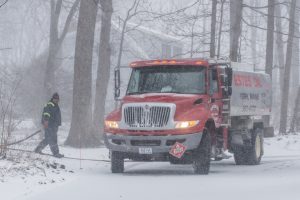
“I think the issue is that over the last 10 to 12 years, people’s philosophy of being attached to an oil company has changed drastically, so you had a lot of customers who were used to getting their fuel within 2 to 3 days being told [by their will-call company] they wouldn’t see oil for 2 to 3 weeks.” Not surprisingly, they started calling around.
As a result, phones rang off the hook from northern Maine to southern Connecticut and beyond. Some companies who use VoIP phones saw their lines crash due to unmanageable call volumes. Others decided to temporarily suspend online advertising, delivery requests and even customer enrollment.
“Probably 50-60 percent of our calls weren’t from Estes Oil & Propane customers,” Estes estimates. And when temperatures started to normalize, around January 8, the company’s heating oil gallons over last year were up “somewhere in the 65-70 percent range,” he says, attributing the increase in part to new customers who called after being unable to find fuel elsewhere.
“It’s been a trying time for all of us,” Estes acknowledges.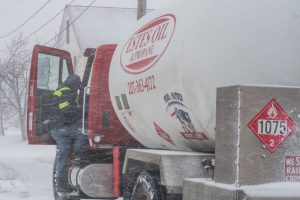
A Couple Silver Linings
About six hours south of Boston (or perhaps double that in this weather), New York’s Bioheat® fuel dealers wrestled with similarly hectic workloads.
Ray Hart, President/CEO of Hart Home Comfort, which serves Queens, Nassau, and Suffolk counties on Long Island, says his company went from delivering around 50,000 gallons of its signature EcoBlend Bioheat® fuel each day during the last two weeks of December to rolling out as much as 70,000-75,000 gallons a day from January 1-10.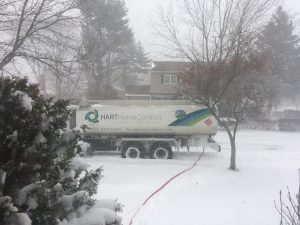
Hart also saw demand for heating equipment service spike. “We average between 40 and 60 service calls a day during the typical January week,” he says. “Over the last week to 10 days, we were getting about 100-120 a day.”
While customer tension and frustration are inevitable in winters like this, Hart’s team took pride in receiving some positive feedback as well, like when one person called specifically to thank everyone at the company for their help and to let them know how “happy and comfortable” he feels knowing they’re here for him.
Even to a business owner who’s “been doing this for 40 years,” that call means a lot, Hart says.
The company president also took comfort in the knowledge that it wasn’t only his team that was being pushed beyond their limitations. “Knowing I was going to do this interview this morning, I opened up today’s newspaper and saw a headline that read something like, ‘Mailboxes empty due to weather and flu outbreak,’” he says. “Clearly every industry is affected!”
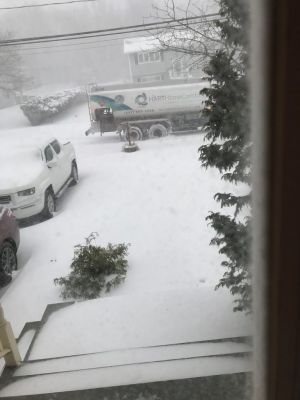
But does any other sector band together quite like this one? Not really, according to MacFarlane. “From receptionists up to owners, you see people pitching in and helping each other,” he says. “They all know there could be that elderly woman down the street who could run out of fuel, and they don’t want to see that happen. That’s what makes our industry unique,” MacFarlane continues. “There is a purpose.”
Related Posts
 U.S. Competing to Secure Critical Minerals
U.S. Competing to Secure Critical Minerals
Posted on June 16, 2025
 The Clean Air Act, the EPA, and State Regulations
The Clean Air Act, the EPA, and State Regulations
Posted on May 14, 2025
 Day Tanks Support Back-up Generators in Extreme Conditions
Day Tanks Support Back-up Generators in Extreme Conditions
Posted on March 10, 2025
 Major Breakthrough in Lithium-Ion Batteries
Major Breakthrough in Lithium-Ion Batteries
Posted on February 12, 2025
Enter your email to receive important news and article updates.
